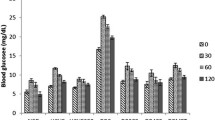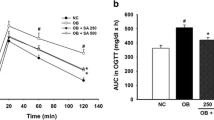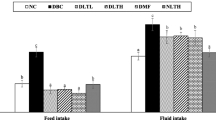Abstract
Introduction
Semecarpus anacardium, known as marking nut, has been used in indigenous system of medicine against various ailments.
Aim
To evaluate the antilipidemic and anti-inflammatory effect of S. anacardium Linn. nut milk extract (SA) in Type 2 diabetic rats.
Materials and methods
Diabetes was induced in rats by feeding them with a high fat diet followed by i.p. of 35 mg/kg body weight of streptozotocin. Diabetic rats were treated with the drugs, SA (200 mg/kg body weight) and metformin (500 mg/kg body weight) for 30 days. Antilipidemic effect of the drug was established by studying the lipoprotein alterations and also the alterations in the lipid profile and lipid metabolizing enzymes in the experimental group of rats. The effect of the drug on the expression of PPAR γ was also studied. To determine the anti-inflammatory effect of the drug, the levels of inflammatory cytokines, TNF-α and IL-6 and also C-reactive protein were determined.
Results and discussion
Semecarpus anacardium nut milk extract at a dosage of 200 mg/kg orally significantly (p < 0.05) reduced and normalized the alterations in the lipid metabolism in diabetic rats effectively than metformin. SA treatment significantly (p < 0.05) increased the mRNA expression of PPAR γ, thereby establishing the antilipidemic effect of the drug. The increase in the levels of inflammatory cytokines were significantly (p < 0.05) brought down to near normal levels on treatment with the drug SA.
Conclusion
The present study thereby establishes the antilipidemic and anti-inflammatory effect of the drug. Thus, by decreasing the alterations in the lipid metabolism and inflammatory status, the drug can effectively improve the insulin sensitivity in rats and can serve as an excellent drug in the treatment of Type 2 diabetes mellitus.

Similar content being viewed by others
References
American Diabetes Association (2009) Standards of medical care in diabetes. Diabetes Care 32(Suppl 1):13–61
Aragno M, Mastrocola R, Catalano MG, Brignardello E, Danni O, Boccuzzi G (2004) Oxidative stress impairs skeletal muscle repair in diabetic rats. Diabetes 53:1082–1088
Aravind SG, Arimboor R, Rangan M, Madhavan SN, Arumughan C (2008) Semi-preparative HPLC preparation and HPTLC quantification of tetrahydroamentoflavone as marker in Semecarpus anacardium and its polyherbal formulations. J Pharm Biomed Anal 48:808–813
Babujanarthanama R, Kavithaa P, Pandianb MR (2010) Quercitrin, a bioflavonoid improves glucose homeostasis in streptozotocin-induced diabetic tissues by altering glycolytic and gluconeogenic enzymes. Fundam Clin Pharmacol 24:357–364
Balakrishnan A, Vishwakarma RA, Anadharajan R, Pathmanathan K, Shankernarayanan NP (2005) Upregulation of GLUT-4 and PPARγ by an isoflavone from Pterocarpus marsupium on L6 myotubes: a possible mechanism of action. J Ethnopharmacol 97:253–260
Bier M (1955) Enzymes of lipid metabolism. Lipases and esterases. Meth Enzymol 1:631–638
Bolen S, Feldman L, Vassy J, Wilson L, Yeh HC, Marinopoulos S, Wiley C, Selvin E, Wilson R, Bass EB, Brancati FL (2007) Systematic review: comparative effectiveness and safety of oral medications for type 2 diabetes mellitus. Ann Intern Med 147:386–399
Bopanna KN, Kannan J, Sushma G, Balaraman R, Rathod SP (1997) Antidiabetic and antihyperlipemic effects of neem seed kernel powder on alloxan diabetic rabbits. Indian J Pharmacol 29:162–167
Chakrabarti S, Biswas TK, Rokeya B, Ali L, Mosihuzzaman M, Nahar N, Azad Khan AK, Borggreve SE, De Vries R, Dullaart RPF (2003) Alterations in high-density lipoprotein metabolism and reverse cholesterol transport in insulin resistance and type 2 diabetes mellitus: role of lipolytic enzymes, lecithin: cholesterol acyl-transferase and lipid transfer proteins. Eur J Clin Invest 33:1051–1069
Chomczynski P, Sacchi N (1987) Single-step method of RNA isolation by acid guanidinium thiocyanate–phenol–chloroform extraction. Anal Biochem 162:156–159
Daynes RA, Jones DC (2002) Emerging roles of PPARs in inflammation and immunity. Nat Rev Immunol 2:748–759
De Whalley CV, Rankin SM, Hoult JR, Jessup W, Wilkins GM, Collard J, Leake DS (1990) Modification of low-density lipoproteins by flavonoids. Biochem Soc Trans 18:1172–1173
Duncan BB, Schmidt MI, Pankow JS, Bang H, Couper D, Ballantyne CM, Hoogeveen RC, Heiss G (2003) Low-grade systemic inflammation and the development of type 2 diabetes: the atherosclerosis risk in communities study. Diabetes 52:1799–1805
Folch J, Less M, Stanely GHS (1951) A simple method for the isolation and purification of total lipids from animal tissues. J Biol Chem 226:49–509
Formulary of Siddha Medicine (1972) 2nd edn. Madras: Indian Medicine Practitioners Co-operative Pharmacy and Stores Ltd, 197
Frayn KN (1993) Insulin resistance and lipid metabolism. Curr Opin Lipidol 4:197–204
Gong W, Lu B, Yang Z, Ye W, Du Y, Wang M et al (2009) Early-stage atherosclerosis in newly diagnosed, untreated type 2 diabetes mellitus and impaired glucose tolerance. Diabetes Metab 35:458–462
Haffner SM (2002) Lipoprotein disorders associated with type 2 diabetes mellitus and insulin resistance. Am J Cardiol 90:55i–61i
Hansen D, Dendale P, Beelen M, Jonkers RA, Mullens A, Corluy L et al (2010) Plasma adipokine and inflammatory marker concentrations are altered in obese, as opposed to non-obese, type 2 diabetes patients. Eur J Appl Physiol 109:397–404
Hitz J, Sternmetz J, Siest G (1983) Plasma LCAT-reference values and effects of xenobiotics. Clin Chim Acta 133:85–96
Horn WT, Menahan LA (1981) A sensitive method for the determination of free fatty acids in plasma. J Lipid Res 22:377–381
Karthikesan K, Pari L, Menon VP (2010) Antihyperlipidemic effect of chlorogenic acid and tetrahydrocurcumin in rats subjected to diabetogenic agents. Chem Biol Interact 3:643–650
Khan HBH, Vinayagam KS, Palanivelu S, Panchanatham S (2011) Antidiabetic effect of Semecarpus anacardium Linn nut milk extract in a high fat diet STZ induced type 2 diabetic rat model. J Comp Clin Pathol 1–6. doi:10.1007/s00580-011-1305-5
Kirana H, Srinivasan BP (2010) Effect of Cyclea peltata Lam. roots aqueous extract on glucose levels, lipid profile, insulin, TNF-α and skeletal muscle glycogen in type 2 diabetic rats. Indian J Exp Biol 48:499–502
Kothai R, Arul B, Kumar KS, Christina AJ (2005) Hypoglycemic and antiperglycemic effects of Semecarpus anacardium linn in normal and alloxan-induced diabetic rats. J Herb Pharmacother 5(2):49–56
Kothari HV, Bonner MJ, Miller BF (1970) Cholesterol ester hydrolase in homogenates and lysosomal fractions of human aorta. Biochem Biophys Acta 202:325–331
Kritikar KR, Basu BD (1993) In: Basu LM, ed. Indian Medicinal Plants, 2nd edn. Allahabad:M/S Bisheh Sigh, Mahendra Palsingh, 667–670
Leffler HH, McDougald CH (1963) Estimation of cholesterol in serum by means of improved technics. Tech Bull Regist Med Technol 33:19–23
Legraud A, Guillansseav RJ, Land J (1979) Method colorimetric simole determination del’activit., de la lecithin cholesterol acyl transferase (LCAT) Plasmatique. Interest on diabeteologic. In: Siest G, Glateau MM (eds) Biologic Prospective. Masson, Paris, pp 368–371
Lo H-C, Tu S-T, Lin K-C, Lin S-C (2004) The anti-hyperglycemic activity of the fruiting body of Cordyceps in diabetic rats induced by nicotinamide and streptozotocin. Life Sci 74: 2897–2908
Mathews DR, Hosker JP, Rudenkl AS, Naylor BA, Treacher DF, Turner RC (1985) Homeostasis model assessment: insulin resistance and β-cells function from fasting plasma glucose and insulin concentrations in man. Diabetologia 28:412–419
Matsuura F, Wang N, Chen XC, Tall AR (2006) HDL from CETP-deficient subjects shows enhanced ability to promote cholesterol efflux from macrophages in an apo E and ABCG1-dependent pathway. J Clin Invest 116:1435–1442
Nair PKR, Melnick SJ, Wnuk SF, Rapp M, Escalon E, Ramachandran C (2009) Isolation and characterization of an anticancer catechol compound from Semecarpus anacardium. J Ethnopharm 122:450–456
Nilsson-Ehle PA, Garfinkel AS, Shotz MC (1980) Lipolytic enzymes and plasma lipoprotein metabolism. Annu Rev Biochem 49:667–693
Parekh AC, Jung DH (1970) Cholesterol determination with ferric chloride-uranyl acetate and sulphuric acid ferrous sulphate reagents. Anal Biochem 42:1423–1427
Parrota JA (2001) Healing plants of peninsular India. CABI Publishing, CAB International, Wallingford, pp 391–392
Patwardan B, Ghoo RB, David SB (1988) A new anaerobic inhibitor of herbal origin. Indian J Pharmacol Sci 50:130–132
Petersen KF, Shulman GI (2006) Etiology of insulin resistance. Am J Med 119:10–16
Picard F, Auwerx J (2002) PPAR (gamma) and glucose homeostasis. Annu Rev Nutr 22:167–197
Premalatha B, Sachdanandam P (2000) Potency of Semecarpus anacardium Linn. nut milk extract against aflatoxin B1-induced hepatocarcinogenesis: reflection on microsomal biotransformation enzymes. Pharmacol Res 42:161–166
Premalatha B, Muthulakshmi V, Sachdanandam P (1999) Anticancer Potency of the milk extract of Semecarpus anacardium Linn. nuts against aflatoxin B1 mediated hepatocellular carcinoma bearing Wistar rats with reference to tumour marker enzymes. Phytother Res 13:183–187
Pushparaj PN, Low HK, Manikandan J, Tan BKH, Tan CH (2007) Anti-diabetic effects of Cichorium intybus in streptozotocin induced diabetic rats. J Ethnopharmacol 111:430–434
Rai PK, Singh SK, Kesari AN, Geeta W (2007) Glycemic evaluation of Psidium guajava in rats. Indian J Med Res 126:224–227
Ramchou M, Harnafi H, Alem C, Benlyas M, Elrhaffari L, Amrani S (2009) Study on antioxidant and hypolipidemic effects of polyphenol-rich extracts from Thymus vulgaris and Lavendula multifida. Res Article 3:106–112
Ramprasath VR, Shanthi P, Sachdanandam P (2006) Immunomodulatory and anti-inflammatory effects of Semecarpus anacardium LINN. Nut milk extract in experimental inflammatory conditions. Biol Pharm Bull 29:693–700
Rastogi RP, Mehrotra BN (1991) Compendium of Indian medicinal plants, vol 2: drug research perspective. Cent Drug Res Inst, Lucknow, p 369
Rouser G, Fkeischer S, Yamamoto A (1970) Two dimensional then layer chromatographic separation of polar lipids and determination of phospholipids by phosphorus analysis of spots. Lipids 5:494–496
Schmidt A (1974) Measurement of lipoprotein lipase and hepatic triglyceride lipase in human postheparin plasma. Meth Enzymol 72:325–337
Sharma R, Mathur VP Dixit (1995) Hypocholesterolemic activity of nut shell extract of Semecarpus anacardium (Bhilawa) in cholesterol fed rabbits. Indian J Exp Biol 3:444–448
Sharma B, Salunke R, Srivastava S, Majumder C, Roy P (2009) Effects of guggulsterone isolated from Commiphora mukul in high fat diet induced diabetic rats. Food Chem Toxicol 47:2631–2639
Sharma AK, Bharti S, Goyal S, Arora S, Nepal S, Kishore K, Joshi S, Kumari S and Arya DS (2011) Upregulation of PPARγ by Aegle marmelos ameliorates insulin resistance and β‐cell dysfunction in high fat diet fed streptozotocin induced type 2 diabetic rats. Phytother Res 10:1457–1465. doi:10.1002/ptr.3442
Sharmila BG, Kumar G, Murugesan AG (2009) Antihyperlipidemic effect of Gar-lip, a polyherbal formulation in streptozotocin induced diabetic rats. Food Chem Toxicol 47:2361–2365
Shaw JE, Sicree RA, Zimmet PZ (2010) Global estimates of the prevalence of diabetes for 2010 and 2030. Diabetes Res Clin Prac. doi:10.1016/j.diabres.2009.10.007
Shen P, Liu MH, Ng TY, Chan YH, Yong EL (2006) Differential effects of isoflavones, from Astragalus membranaceus and Pueraria thomsonii, on the activation of PPARα, PPARγ, and adipocyte differentiation in vitro. J Nutr 136:899–905
Shin YG, Cordell GA, Dong Y, Pezzuto JM, Appa Rao AVN, Ramesh M, Ravi Kumar B, Radhakishan M (1999) Rapid identification of cytotoxic alkenyl catechols in Semecarpus anacardium using bioassay-linked high performance liquid chromatographyelectrospray/mass spectrometric analysis. Phytochem Anal 10:208–212
Sniderman AD, Lamarche B, Tilley J, Seccombe D, Froflich J (2002) Hypertriglyceridemic hyperapo B in type 2 diabetes mellitus. Diabetes Care 25(3):579–582
Srinivasan K, Ramarao P (2007) Animal models in type 2 diabetes research: an overview. Indian J Med Res 125:451–472
Srinivasan K, Viswanad B, Lydia Asrat CLK, Ramarao P (2005) Combination of high-fat diet-fed and low-dose streptozotocin-treated rat: A model for type 2 diabetes and pharmacological screening. Pharmacol Res 52:313–320
Staels B, Fruchart JC (2005) Therapeutic roles of peroxisome proliferator-activated receptor agonists. Diabetes 54:2460–2470
Sujatha V, Sachdanandam P (2002) Recuperative effect of Semecarpus anacardium Linn. nut milk extract on carbohydrate metabolizing enzymes in experimental mammary carcinome-bearing rats. Phytother Res 16:S14–S18
Surveswaran S, Cai Y-Z, Corke H, Sun M (2007) Systematic evaluation of natural phenolic antioxidants from 133 Indian medicinal plants. Food Chem 102:938–953
Tahrani AA, Piya MK, Kennedy A, Barnett AH (2010) Glycaemic control in type 2 diabetes: targets and new therapies. Pharmacol Ther 125:328–361
Taskinen MR (2002) Diabetic dyslipidemia. Atherosclerosis Supplements 3:47–51
Trinder P (1969) Determination of blood glucose using an oxidase-peroxidase system with a noncarcinogenic chromogen. J Clin Pathol 22:158–161
Umarani M, Shanthi P, Sachdanandam P (2008) Protective effect of Kalpaamruthaa in combating the oxidative stress posed by aflatoxin B1-induced hepatocellular carcinoma with special reference to flavonoid structure–activity relationship. Liver Int 28:200–213
Van Handel E (1961) Suggested modifications of the micro determination of triglycerides. Clin Chem 7:249–251
Vijayalakshmi T, Muthulakshmi V, Sachdanandam P (2000) Toxic studies on biochemical parameters carried out in rats with Serankottai nei, a siddha drug–milk extract of Semecarpus anacardium nut. J Ethnopharm 69:9–15
Wajngot V, Chandramouli WC, Schumann K, Ekberg PK, Jones S, Efendic BR, Landau (2001) Quantitative contributions of gluconeogenesis to glucose production during fasting in type 2 diabetes mellitus. Metabolism 50:47–52
Wilson DE, Spiger MJ (1973) A dual precipitation method for quantitative plasma lipoprotein measurement without ultracentrifugation. J Lab Clin Med 82:473–482
Xie WD, Du LJ (2005) High-cholesterol diets impair short-term retention of memory in alloxan-induced diabetic mice, but not acquisition of memory in prediabetic mice. Life Sci 77:481–495
Xu H, Barnes GT, Yang Q et al (2003) Chronic inflammation in fat plays a crucial role in the development of obesity related insulin resistance. J Clin Invest 112:1821–1830
Zhang H, Chen S, Deng X, Yang X, Huang X (2006) Danggui–Buxue–Tang decoction has an anti-inflammatory effect in diabetic atherosclerosis rat model. Diabetes Res Clin Pract 74:194–196
Zhang L, Yang J, Chen X-q, Zan K, Wen X-d, Chen H, Wang Q, Lai M-x (2010) Antidiabetic and antioxidant effects of extracts from Potentilla discolor Bunge on diabetic rats induced by high fat diet and streptozotocin. J Ethnopharmacol 132:518–524
Author information
Authors and Affiliations
Corresponding author
Rights and permissions
About this article
Cite this article
Khan, H.B.H., Vinayagam, K.S., Moorthy, B.T. et al. Anti-inflammatory and anti-hyperlipidemic effect of Semecarpus anacardium in a High fat diet: STZ-induced Type 2 diabetic rat model. Inflammopharmacol 21, 37–46 (2013). https://doi.org/10.1007/s10787-011-0109-1
Received:
Accepted:
Published:
Issue Date:
DOI: https://doi.org/10.1007/s10787-011-0109-1




